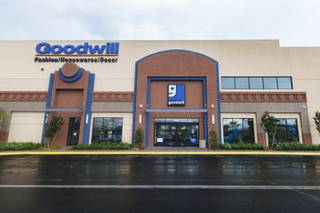Goodwill of Southern Nevada is known as a place to donate clothing, electronics, kitchenware and other household goods. Someone out there wants your hand-me-downs, right?
More than you might think — and Goodwill is betting big on it.
The nonprofit thrift store and job-training group has more than doubled its stores over the past four years. Goodwill operated eight retail stores by spring 2012; it now has 17 and plans to open three more by year’s end, executives say.
One of its newest locations occupies part of the former Dillard’s department store at Boulevard mall. The 28,000-square-foot store, which opened in October, is the largest in Goodwill’s 40-year local history and the first Goodwill nationally to open in a major, enclosed shopping mall.
The group also borrowed $22 million last year, through a bond sale, to buy three of its newly built stores and not operate in those properties as a rent-paying tenant.
Overall, the size and scope of Goodwill’s business has grown alongside its store count.
Last year, it received about 816,000 donations, booked $25 million in store sales, provided career services to more than 12,000 people and had a staff of 860, the group says.
In 2011, Goodwill received about 478,000 donations, booked $14 million in store sales, provided career services to 8,500 people and had a staff of 465.
CEO Steve Chartrand, Chief Operating Officer Alyn Reeves and Vice President of Retail and Operations Chris Matlock recently met with the Las Vegas Sun at Goodwill’s store at Boulevard mall to talk about the group. Edited excerpts:
Over the next, say, five to 10 years, do you have a timeline for how many more stores you hope to open?
Reeves: It really depends on donation flow. We need the donations to open stores and keep them full and fresh with merchandise. Our plan right now is to open two stores a year — not indefinitely, but as long as the donations allow us to.
How does that expansion rate compare to other Goodwills?
Reeves: It depends. Some have been expanding aggressively for years, and others only maybe recently. It really depends on the market and the amount of donations they get. We are growing because we have the need and the ability to grow. Some Goodwills that have been around a lot longer have pretty much maximized their territory, so they don’t have the ability to grow, or they may be in a part of the country where the population’s actually decreasing. There are Goodwills that are closing stores.
Is one of the reasons you started growing fast in 2012 because the real estate market was so bad, and you got cheap retail rents and could build stores relatively cheap because construction costs had come down so much?
Reeves: Partly. When I joined Goodwill in 2010 — I came in as vice president of retail — like you said, that was a good time to expand. There were a lot of vacant boxes out there. The Fort Apache and Flamingo store, for instance, was a former Rite Aid.
Matlock: Also, beyond the real estate opportunities we came across — which were obviously very advantageous for us — beyond that was just serving the community. The amount of people who needed to be served was huge because of the recession. Our main focus here is to put people back to work. The more stores we can open, the better we can do to capitalize on donations and the sale of those goods. That was really our focus: to double in size so we could provide more services.
Chartrand: For us, one of the key things is we have to have the volume of quality, donated goods. We haven’t figured out how to sell empty shelves — I don’t think any retailer has. Really, that is the key. Once we determined this market had that potential, then we figured out how many stores. It’s not really tied to the recession — the recession gave us the opportunity to get some good deals for store space, but it’s not the reason we did it.
Why do the bond sale? Why was it important to buy stores instead of renting them as a tenant?
Reeves: So we could have those assets on our books. When you own a property, and you’re a nonprofit, you don’t pay property taxes. Each one of those locations, we save about $35,000 a year in property taxes because we own them.
What’s the cost difference between renting, even factoring in the savings in property taxes?
Reeves: It really varies per location. But we absolutely save money. We wouldn’t have done it if we weren’t.
What about increased competition from other used-clothing stores such as Buffalo Exchange?
Reeves: That is a changing part of the business — businesses that pay for your goods, such as Buffalo Exchange or Plato’s Closet. But our main competitors are the for-profit thrift stores such as Savers or Epic, partly because of the number of stores they have. Savers has six locations in the valley.
Did you notice a change in sales at your stores after the recession than prior to it?
Reeves: It’s hard to say, but certainly when donations drop, your sales go down. A lot of people think we’d do great in a recession, because people are shopping thrift stores. But in reality, in a bad economy, people donate less, so there’s less to sell. We don’t do better in a slow economy than traditional retail does.



Join the Discussion:
Check this out for a full explanation of our conversion to the LiveFyre commenting system and instructions on how to sign up for an account.
Full comments policy